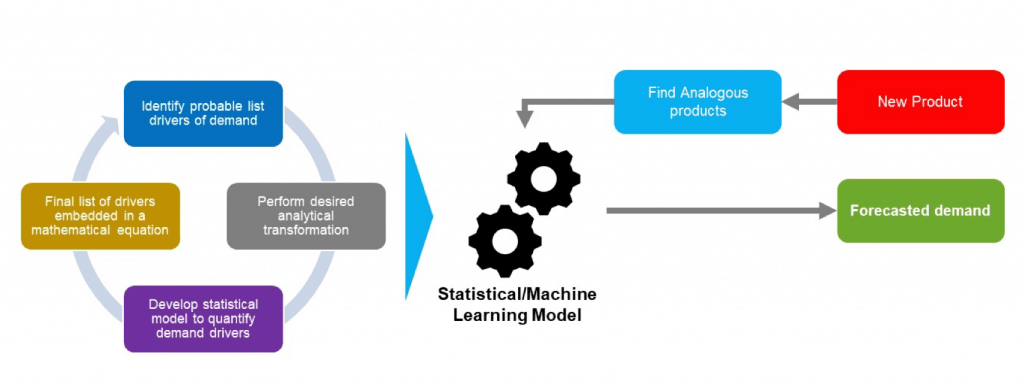Demand is the key indicator for every business to consider before taking the first step or expanding in the chosen market segment. It drives economic growth while central banks and governments boost demand to end down-sliding. Demand Prediction, which is part of Predictive Analytics and Machine Learning in Retail, implies an evaluation of the number of goods and services that consumers will probably buy in the future. The most critical business factors such as turnover, profit margins, cash flow, capital expenditure, risk assessment, mitigation plans, capacity planning, etc. are directly dependent on demand.
What are the 5 Determinants of Demand?

The 5 Determinants of Demand are the following:
- Product price.
- Customers’ income.
- Prices of complementary goods or services.
- Customers’ tastes.
- Customers’ expectations.
Don't have time to read?
Book a free meeting with our experts to discover how we can help you.
Book a MeetingHow Each Determinant of Demand Affects It
A better way to understand how each determinant affects demand is to assume that all other determinants, except for this one, do not change. So, all other indicators being equal, let’s take a look at each of them separately:
Product price
When prices rise, demand falls – that’s what the Law of Demand tells us. Subsequently, when prices drop, demand rises. Purchasing decisions are usually guided by price if all other factors are equal.
Customers’ income
When income rises, demand rises as well. But it’s not always that you would like to buy twice as much of a certain good or service. For example, earning more does not mean you need two, three, or four different shoe horns, because one is enough for everyday usage.
Prices of complementary goods or services
The price of related goods and services will also raise the cost of using the product you need, so you will want less. The example might be a price for gas that rose $4 a gallon in 2008. Consequently, the demand for Hummers dropped for one reason — gas is a related product to Hummers.
Demand rises also when the consumers’ tastes, preferences, and desires change, and they suddenly begin to like the product. And vice versa, if consumers’ tastes change to not favor a product, demand drops. Advertising a brand can influence consumers’ desires for a product. Expectations, along with actual desires, also affect the level of demand. That is when people expect that a product will have more value, they increase the demand for it.
Types of Demand Forecasting
The types of Demand Forecasting vary and can be influenced by multiple factors such as time span, the scope of the market, or the level of detailing. They are split into two groups: time period based and economy based. Let’s take a look at what subtypes correspond to each of these two types.

Economy based
Macro-level prediction
This forecasting type considers the overall economic environment, dealing with the economy measured by the Index of Industrial Production, the country’s level of employment, national income, etc.
Industry-level prediction
Industry-level prediction, obviously, deals with the demand that a particular industry’s products will have. For example, the demand for cars in the USA, the demand for electric scooters in the USA, etc.
Brand-level forecasting
Brand-level forecasting means predicting the demand for the products of a particular brand or firm, such as Adidas, Nike, etc.
Time period based
Short-term forecasting
This one deals with a short time span such as six months or less than a year, but it depends on the nature of the industry. Short-term forecasting is more suited for fast decisions rather than strategy.
Long-term forecasting
Long-term forecasting implies making forecasts for a long period of time, such as two to five years or more. This forecasting type can give valuable strategic information to a business (e.g., moving to another market segment, extending a plant’s capacity, etc.).
Demand Prediction Examples
Real-world examples of where Demand Prediction can be applied are as numerous as the types of businesses that exist. However, here are some explicit Demand Prediction examples for different industries.
Car market
If some famous carmaker has been collecting data on the last year’s worth of sales with each car’s model, engine type, and color, he can make a short-period forecast to learn what car model will be the most demanded in the next 12 months or so.
Food manufacturing industry
If a leading food manufacturing company has information on the sales of seasonal products in the last two years, it can be used to predict the preferred flavor or package size for the next year or two in order to plan for purchase, production, and inventory.
Find out more: Machine Learning in The Food Industry
Beauty industry
Let’s imagine a particular cosmetics brand was selling 10,000 orders a month during a certain season of the year. Considering this historical data, it can be predicted that the trend for this product line will increase to 30,000 items sold per month during the next year.
Retail industry
Imagine you have an inventory store that sells about 5,000 items a month. One day you notice that not all items are sold in equal numbers. Some products sell quickly and others remain on the shelves for a long time. In this case, you can make a Demand Prediction mapped for at least a six-month period. Now, you can significantly reduce the amount of money spent on purchasing things of low interest to customers. Artificial Intelligence or AI for Retail in 2023 is a very vast field in which Demand Prediction methods can be used.
Types of Forecasting Methods
There are two major types of forecasting methods: qualitative and quantitative, which also have their subtypes.
Qualitative forecasting methods
- The Delphi Technique. Experts are given a task to forecast demand in each specific segment. The initial forecasting round is held and then each expert uncovers his forecast so that every expert’s opinion is influenced by other experts. The process repeats until all experts come to a similar decision.
- Sales Force opinion. Teams of salespersons are asked about expected demand inputs. Every salesperson has to estimate his own relevant region and product type as well as give a report on the demand of the customers with whom they worked. The Sales Manager takes the results into consideration and executes a final decision as to what the Demand Forecast should look like.
- Market Research. When this method of Demand Forecasting is used, customers are given specific surveys to collect opinions and generate potential demand. These are usually questionnaires that aggregate demographic, economic, and preference information from customers. This method is beneficial when there is very little or no sales history for a product.
Quantitative forecasting methods
These methods suit only businesses with a rich historical database for years of sales.
- Trend projection method. The trend projection method uses a time series approach to represent past sales and the projected demand for a certain product category by means of graphical plotting and the least square techniques.
- Barometric technique. This is based on capturing events in the present to forecast the future. The barometric technique implies analyzing statistical and economic indicators with formulas such as Concurrent or Lagging series and Leading series.
- Econometric forecasting technique. Complex mathematical equations and an autoregressive integrated moving average are used in the econometric forecasting technique to create relationships between demand and its factors. A mathematically based equation is deduced to come to a decent historical representation. Ultimately, the forecast is drawn upon the projected values that are entered into the equation.
How to Predict Demand with Machine Learning

Machine Learning models, a part of AI solutions development, are among the quantitative methods of supply and demand analysis that rely on statistics and sophisticated mathematical formulas, rather than field experts’ opinions. In this part, you will learn how to forecast demand with Machine Learning — a top-notch method in the world of business. Previously we had published Machine Learning in Banking to learn about more examples from this industry.
Machine Learning derives predictions out of historical data on sales to build a strategy and is precise enough to hit one’s business goals. The world’s leading Internet giants such as IBM, Google, and Amazon all use Demand Prediction tools empowered by Machine Learning.
The first thing you should know before implementing Machine Learning for Demand Forecasting is that the models need lots of quality data from internal and external sources of information. Intelligent algorithms can work with both structured and unstructured data, such as financial and sales reports, macroeconomic indicators, marketing polls, social media content (e.g., likes, shares, Tweets), weather forecasts, and much more. Big Data and Its Business Impacts will remain significant as long as data is the literary fuel of the modern world.
| Internal data sources | External data sources |
|---|---|
| E-commerce sales data | Social Media |
| Inventory | Internet of Things |
| Purchase orders | Geological devices |
| Sales transactions | Click streams |
| Loyalty Cards | Customer store receipts |
| Point of Sale information | Household panel data |
| Reviews | Government Census |
| Marketing campaigns | Weather |
| In-store devices | Third-party syndicated data |
| Websites and more | Videos |
Machine Learning is so potent because it is driven by robust mathematical algorithms that can recognize patterns automatically as well as capture complicated hidden relationships and demand signals from the data extracted from the sources listed above. These smart models not only analyze massive amounts of data but they also permanently retrain models on the basis of new information to adjust them to changing conditions, which, in effect, leads to more reliable forecasts.
How accurate are these forecasts? Companies that have already adopted Machine Learning driven solutions report having achieved an increase of 5%-15+% of prediction reliability compared to conventional methods. In some cases, accuracy is as high as 85% or even 95%. Machine Learning for Demand Forecasting works best in short-term and mid-term planning, fast-changing environments, volatile demand traits, and planning campaigns for new products.
Top 6 Tips on How Demand Forecasting Can Secure Your Business Strategy
Obviously, the role of Demand Forecasting is crucial for any type of business and its management in particular. Using the strong sides of Demand Prediction, an organization can reduce risks in its business activity and make informed business decisions. Additionally, Demand Forecasting contributes to the capital investment and expansion decisions of an organization.
Here are 6 tips that will significantly secure your next business decision.
Tip 1: Reaching the right business goals
We cannot imagine a business that does not have pre-defined objectives at its very inception. Otherwise, it’s just like a captain of the ship that does not have a compass and just goes in a random direction. Demand Forecasting helps to reach the needed objectives. A business can evaluate the current demand for its goods and services on the market and achieve its set objectives. In the event that the organization has a goal of selling a certain number of products, but Demand Forecasting shows that the actual demand on the market for this particular product is low, the enterprise may cease producing this type of goods to avoid losses.
Tip 2: Predicting the budget
Expected cost and revenue estimation play a critical role in preparing the budget. For example, when a business has forecasted the demand goods that have a price of $10 and the demand is predicted as 1,000 units, it will become clear that the estimated revenue is $10,000.
Tip 3: Recruitment and production activities
An organization can avoid wasting resources if it runs a Demand Forecasting strategy produces only the number of products for which demand is predicted. Furthermore, this will help an organization make more efficient hiring decisions. For instance, if there is a high demand for goods, a business may need extra employees to meet the increased demand.
Tip 4: Scaling the business
Demand Forecasting helps a business decide whether it is time to scale because of the increased value of its products on the market. On the flip side, maybe there is a need to stop investing in the business because of low demand numbers.
Tip 5: Making the right management decisions
Drastically influential decisions such as choosing a plant’s capacity, identifying the requirements for raw material, and ensuring the availability of labor and capital have to be guided to avoid loss of revenue.
Tip 6: Estimating performance
If the demand for the products sold by a business is low, there’s a high chance that this business should make a change such as improving the quality of its goods or investing more resources into marketing campaigns.
Conclusion
Demand Forecasting is vital for businesses of all sizes to generate revenue and avoid capital losses. The need for Demand Forecasting is evident in many diverse industries and use cases; it’s the best method to implement to make the right management decisions, scale the business, launch a new product, or predict the budget.
Ready to speed up your Software Development?
Explore the solutions we offer to see how we can assist you!
Schedule a Call
